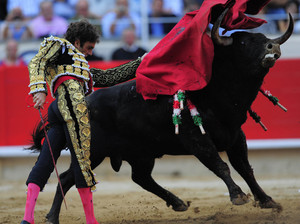Ask anyone in Spain, and they will all say that bullfighting is one of the most legendary traditions in Spain that has influenced, moved, and enkindled the

works of writers such as Ernest Hemingway and Paco Mateo as well as painters like Pablo Picasso and Francisco Goya, not to mention enticed the world of spectators, tourists, and avid fans to their arenas.
However, a regional ban has put an end to the time-honored tradition, at least in Catalonia, after 180,000 petition signatures were collected. Although the last bullfight occurred on Sept. 25 at Barcelona’s Monumental Bullring, this ban is set to take effect beginning Jan.1, 2012. Elisabeth Barcelo, an animal rights activist, has supported the ban as an end to the abuse of bulls: “Bulls are not aware of what they do, but people are. So I don’t like it. It’s torturing an animal. It doesn’t make any sense to me.” Consistent with this, Leonardo Anselmi hopes that other areas will take notice and follow suit: “It’s like a crack has developed in the armor plating [of bullfighting]. It’s a small crack but the protective shield might crumble altogether.”
While this ban comes at the heels of fervent animal rights activists, many speculate that the economy is just one of the things that have plagued the epic sport. In fact, tickets for bullfights are so expensive that people have stopped attending as a result. According to npr.org, attendance has plummeted in recent years from 2,622 in 2007 to 1, 724 in 2010. Sources say that there is not enough money to buy wholesome, sturdy bulls. In turn, the bulls that are affordable must be spurred and provoked into fighting by the toreros because they are too weak to fight. This, bullfighter writer Paco Mateo says, paints a negative appearance of the sport but blames the selfishness of companies who are responsible for giving a bad name: “The people killing the bulls aren’t the fighters; it’s those who are trying to save money. In the world of bullfighting, there’s much corruption.”
Coupled with this, politics is also being blamed for Catalonia’s opposition to bullfighting. “Bullfighting is the history of Spain. It’s the tradition in Spain. Barcelona is anti-bullfight because it’s anti-Spain,” says local fan Antonio Gutierrez. Gutierrez is just one of many who believe that this move to seemingly resist anything Spanish was done by Catalonia to assert its own independence and preserve some of the culture and identity that was lost with Francisco Franco’s 40-year dictatorship.
Despite this, others like Carlos Nuñez, President of Spain’s Mesa del Toro pro-bullfighting umbrella group, would like to see bullfighting return. He, like others, admits that bullfighting can be seen as vicious, but nevertheless accepts and respects the sport that many have grown up with and that many have embraced as a symbol of not only Spanish heritage and custom, but also of bravery and, ultimately, freedom: “Banning bullfighting in Catalonia is nothing more than an attack on liberty. It’s the fruit of policies in Catalonia against bullfighting and all that is seen to represent Spain. ” Currently, Catalonia stands as one of seventeen areas in Spain to outlaw bullfighting.







